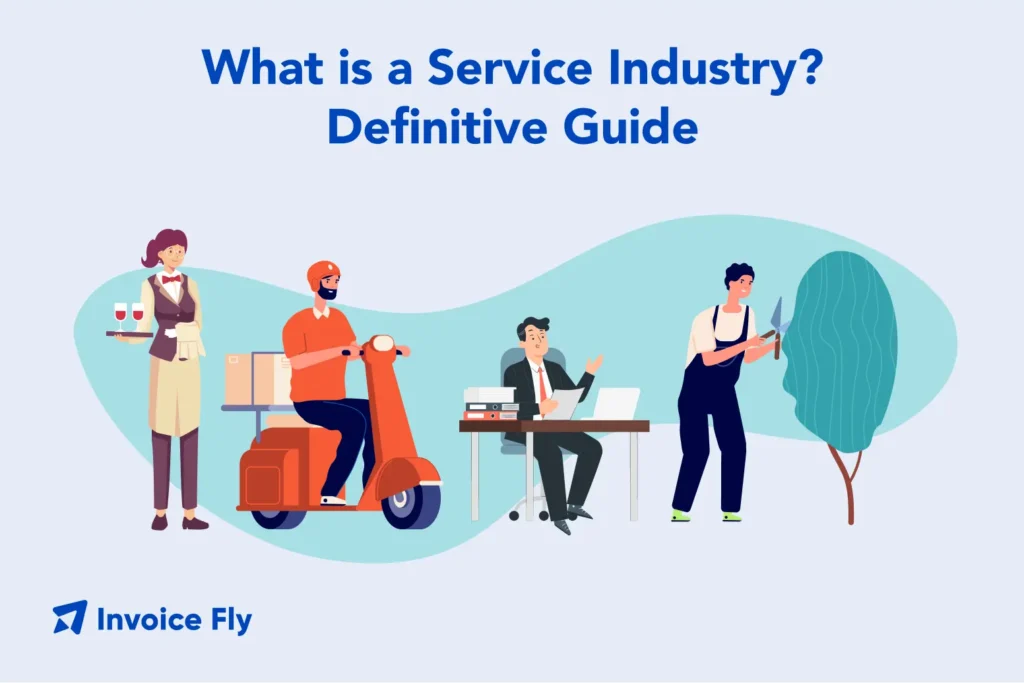What is a Service Industry? | Definitive Guide

Table of Contents
The service industry is one of the biggest parts of today’s economy. It includes many fields, like hospitality, finance, education, and technology. Unlike companies that make or sell physical products, service businesses provide value through skills, experiences, and customer support.
In this guide, you’ll learn what the service industry is, see real examples of it, and discover how it’s changing and growing in 2025 and the years ahead.
Need tools to run your business better? Try Invoice Fly’s Business Reports to track performance and make smarter decisions!
Get Started with Invoice Fly’s Software
Invoice Fly is a smart, fast, and easy-to-use invoicing software designed for freelancers, contractors, and small business owners. Create and send invoices, track payments, and manage your business — all in one place.

What Is the Service Industry?
The service industry represents the portion of the economy that produces services rather than tangible goods. According to Investopedia, the service sector produces intangible goods—more precisely services instead of goods—and comprises various service industries including warehousing and transportation services, information services, securities and other investment services, professional services, waste management, health care and social assistance, and arts, entertainment, and recreation.

A Simple Definition
In simple terms, the service industry is any business that helps people, solves problems, or provides experiences without selling physical products you can touch or take home. Instead of manufacturing items like cars or furniture, service businesses deliver value through knowledge, expertise, labor, and customer experiences.
Service industry workers might cut your hair, fix your plumbing, teach your children, manage your finances, or entertain you at a concert. The common thread is that they’re providing a service, completing tasks, sharing expertise, or creating experiences.
How It’s Different from Making or Selling Products
Understanding the service industry becomes clearer when you compare it to other economic sectors:
Manufacturing Industries: These businesses create physical products like cars, clothing, electronics, or furniture. You can touch, store, and own these items.
Service Industries: These businesses provide intangible benefits like haircuts, medical care, legal advice, or entertainment. You can’t physically hold a service, but you experience its value.
Key Differences:
- Product vs. Experience: Manufacturing produces things you own; services create experiences or results
- Inventory: Manufacturers store inventory; service providers can’t stockpile their offerings
- Consumption: Products can be used later; services are consumed as they’re delivered
- Evaluation: Product quality is visible; service quality depends on customer experience
For example, a restaurant combines both: the kitchen manufactures food (goods), but the dining experience, table service, and atmosphere represent the service industry side.

How the Service Industry Works
The service industry operates differently from traditional manufacturing businesses, but it’s become the dominant force in modern economies.
The Three Parts of the Economy: Primary, Secondary, and Tertiary
Economists divide economic activity into three sectors:
| Primary Sector | Secondary Sector | Tertiary Sector (Service Industry) | |
| Description | Involves extracting natural resources directly from the environment. Workers harvest or extract materials used by other industries. | Focuses on transforming raw materials into finished goods through manufacturing, processing, and construction. | Produces intangible goods and services such as repairs, consulting, training, and customer support. According to Investopedia, this is the third tier of the three-sector economy. |
| Examples of Industries | Farming, mining, fishing, forestry | Factories, construction, food processing, manufacturing plants | Healthcare, finance, education, hospitality, IT, consulting |
| Key Role in the Economy | Provides raw materials for manufacturing and construction. | Creates tangible products for consumers and businesses. | Delivers experiences, expertise, and support services that drive modern economies. |
In developed economies like the United States, the United Kingdom, Australia, and China, the tertiary sector dominates economic activity. The service industry is responsible for the largest portion of the global economy’s business activity and employs the majority of workers.
What People in the Service Industry Actually Do
Service industry workers perform countless different tasks, but they all share common characteristics:
- Direct Customer Interaction: Most service workers interact directly with customers, clients, or the public. Customer service is central to success in this sector.
- Problem Solving: Service professionals diagnose issues and provide solutions—whether that’s fixing a leaky pipe, curing an illness, or helping someone plan their finances.
- Specialized Knowledge: Many service jobs require specific expertise, training, or certification. This specialized knowledge creates value for customers who lack that expertise themselves.
- Experience Creation: From hotel stays to concerts, many service businesses focus on creating positive, memorable experiences for their customers.
- Support Services: Behind-the-scenes service workers support other businesses by handling tasks like accounting, marketing, or IT management.
Common Types of Service Industries
The service industry encompasses dozens of distinct sectors. Here are the major categories:
Professional and Business Services (Consulting, Finance, Marketing)
Professional services deliver specialized expertise to businesses and individuals. This broad category includes:
- Financial Services: Banks, investment firms, insurance companies, and accounting practices help people and businesses manage money, protect assets, and plan for the future. The financial services industry handles everything from everyday checking accounts to complex corporate transactions.
- Consulting: Consultants offer expert advice to help businesses improve operations, strategy, technology, or management. They analyze problems and recommend solutions based on their specialized knowledge.
- Marketing and Advertising: Marketing professionals help businesses reach customers through campaigns, branding, social media, and creative content. The advertising services industry continues growing as businesses compete for consumer attention online and offline.
- Legal Services: Lawyers, paralegals, and legal staff provide representation, advice, and document preparation for individuals and businesses navigating the legal system.
These professional services typically require advanced education, certifications, or extensive experience. Many professionals in this sector work independently or in small firms, making concepts like service business operations essential knowledge.
Hospitality, Food, and Tourism
The hospitality industry focuses on creating welcoming experiences for guests and customers:
- Hotels and Accommodations: From budget motels to luxury resorts, the hotel industry provides temporary housing for travelers and creates memorable guest experiences.
- Food Service: Restaurants, cafes, catering companies, and food trucks prepare and serve meals. The food service industry employs millions of workers including chefs, servers, bartenders, and restaurant managers.
- Tourism and Travel: Travel agents, tour guides, event planners, and tourism boards help people explore new places and create travel experiences.
This sector depends heavily on customer satisfaction, positive reviews, and repeat business. Employment in leisure and hospitality includes significant seasonal variation based on travel patterns.

Health, Education, and Public Services
Essential service industries that support community well-being include:
- Healthcare: Hospitals, clinics, dental offices, and care facilities employ doctors, nurses, therapists, technicians, and support staff who diagnose, treat, and care for patients. Healthcare organizations face high-stakes expectations for clinical care, support services, and essential infrastructure.
- Education: Teachers, professors, tutors, and trainers provide knowledge and skills to students of all ages. Educational services range from preschools to universities to professional training programs.
- Public Service: Government employees, police officers, firefighters, postal workers, and sanitation workers provide essential services that keep communities safe, clean, and functioning. Public sector agencies manage public programs, infrastructure, and policy under tight budgets and public scrutiny.
According to the Bureau of Labor Statistics, education and health services represent one of the largest supersectors within service-providing industries, with millions of employees nationwide.
Personal and Home Services (Cleaning, Repairs, Tutoring)
Personal service industries help individuals with everyday needs:
- Home Services: This rapidly growing category includes plumbing, electrical work, HVAC, roofing, and handyman services. Home services industry trends in 2025 show continued growth as homeowners invest in maintenance and improvements.
- Landscaping and Lawn Care: Landscaping businesses and lawn care services maintain outdoor spaces, combining physical labor with aesthetic expertise.
- Cleaning and Maintenance: Housekeeping services, janitorial companies, and specialized cleaners like pressure washing businesses keep homes and businesses clean.
- Personal Care: Hair salons, spas, fitness trainers, and wellness coaches help people look and feel their best.
Tech and Online Services (Freelancing, IT, SaaS Tools)
- Technology has created entirely new service categories:
- Information Technology: IT support, software development, cybersecurity, and network management help businesses leverage technology effectively. Managed services industry providers handle ongoing IT needs for companies without in-house expertise.
- Software as a Service (SaaS): Cloud-based software companies provide subscription access to tools for project management, accounting, communication, customer relationship management (CRM), and countless other business functions.
- Freelance Services: Online platforms connect freelancers with clients needing graphic design, writing, programming, virtual assistance, and other digital services.
- Digital Marketing: SEO specialists, social media managers, and digital advertisers help businesses succeed online.
Technology in the service industry continues reshaping how services are delivered, with businesses increasingly placing focus on what’s becoming known as the knowledge economy—the ability to surpass competitors by understanding what target customers want and need.
Tip: See the Census Bureau How Are Service Industries Trending? guide to see how they all compare.
Why the Service Industry Matters
The service economy dominates modern developed nations for several important reasons:
- Economic Impact: In the United States, approximately two-thirds of economic activity occurs in the service sector. Service-providing industries are responsible for the largest portion of GDP in most developed countries.
- Employment: According to the Bureau of Labor Statistics, service-providing industries employed approximately 137.9 million people as of August 2025, representing the vast majority of American workers.
- Essential Services: Many service industries provide essential functions that communities depend on daily—healthcare, education, public safety, utilities, and transportation.
- Quality of Life: Services like entertainment, hospitality, and personal care enhance people’s quality of life beyond basic survival needs.
- Economic Development: A strong service sector is often an indicator of a healthy, developed economy. Countries with economies centered around the service sector are considered more advanced than industrial or agricultural economies.
- Innovation Driver: The service industry constantly innovates in how it delivers value, adopts new technology, and meets changing customer expectations.
Why More People Are Starting Service-Based Careers
Service industry jobs attract workers for several compelling reasons:
- Accessibility: Many service positions don’t require expensive equipment or large capital investments to get started. You can launch a painting business or consulting practice with relatively low startup costs.
- Job Security: During economic downturns, people generally reduce spending on material goods but still need essential services, providing relative job security.
- Diverse Opportunities: The service sector offers positions for every skill level, education background, and interest area—from entry-level customer service to highly specialized professional services.
- Entrepreneurship: Service businesses often have lower barriers to entry than manufacturing, fostering small business ownership and entrepreneurship.
- Personal Satisfaction: Many service workers find fulfillment in helping others, solving problems, and making direct positive impacts on customers’ lives.
- Flexible Schedules: Service industries often offer flexible hours, allowing workers to balance work with education, family, or other priorities.
- Growing Demand: As populations age and technology advances, demand for many service industry jobs continues increasing.
Challenges the Service Industry Faces
Despite its dominance, the service industry confronts significant challenges:
- Labor Shortages: Many service sectors struggle to find and retain qualified workers, particularly in healthcare, hospitality, and skilled trades. Workforce shortages create stress on existing employees and limit business growth.
- Inconsistent Quality: Unlike manufactured products with quality control, services depend on individual workers’ performance, making consistency challenging. One bad interaction can damage a business’s reputation.
- Difficult to Scale: Service businesses often struggle to grow because they’re labor-dependent. You can’t stockpile services or mass-produce them like physical goods.
- Technology Disruption: Automation and artificial intelligence threaten to replace some service jobs, particularly routine tasks like data entry or basic customer service.
- Economic Sensitivity: Certain service sectors like hospitality and entertainment are highly sensitive to economic conditions and disposable income levels.
- Pricing Pressure: Customers often undervalue services compared to physical products, making pricing strategies complex. Understanding hourly vs flat rate pricing becomes crucial for service businesses.
- Training Requirements: Many service positions require ongoing training as technology, regulations, and best practices evolve, creating costs for businesses and workers.
- Competition: Low barriers to entry in some service sectors create intense competition, driving down prices and profit margins.
The Future of the Service Industry
Several trends are shaping where the service industry is headed:
- Technology Integration: Businesses in the service sector are rapidly adopting new technology. Information technology systems are reshaping how service businesses operate, with tools helping them move fast, stay accurate, and put people first.
- Hybrid Models: More businesses are blending physical and digital service delivery, offering both in-person and online options to meet diverse customer preferences.
- Personalization: Service providers increasingly use data and customer relationship management (CRM) systems to tailor experiences to individual preferences and needs.
- Subscription Services: Managed services models and subscription-based service delivery continue growing across industries, from software to lawn care.
- Sustainability Focus: Consumers increasingly value environmentally responsible service providers, driving changes in operations across hospitality, transportation, and other sectors.
- Remote Work Impact: The shift to remote work has increased demand for home improvement services while reducing demand for some commercial services like office cleaning.
- Healthcare Expansion: Aging populations drive continued growth in healthcare and related support services.
- Experience Economy: Consumers increasingly prioritize experiences over possessions, benefiting entertainment, travel, and leisure services.
- Gig Economy Growth: More workers operate as independent contractors in the service sector, requiring tools like invoice makers and quote templates to manage their businesses professionally.
Managing Your Service Business Finances
Whether you’re offering professional consulting, fixing homes, or running any other type of service business, staying on top of your finances is key to long-term success. Here’s how to keep things running smoothly:
- Start with accurate pricing. Use a service price calculator to make sure your rates cover all your costs—and leave room for profit. When you truly understand your expenses, it’s easier to stay competitive without undercharging.
- Next, focus on professional invoicing. Send polished, consistent invoices using a free invoice template or try our automated invoice maker to help you get paid faster and stay organized.
- Clear quotes are just as important. Create detailed, professional estimates using quote templates so clients know exactly what to expect.
- Keep an eye on your numbers. Regularly track your income, spending, and profitability to see what’s working—and where you might need to adjust.
- And don’t forget about taxes. Understand what you owe, set money aside throughout the year, and take advantage of deductions available to service businesses.

Final Thoughts
The service industry represents the backbone of modern economies, employing the majority of workers and generating most economic activity in developed nations. From essential services like healthcare and education to quality-of-life enhancements like entertainment and hospitality, service businesses touch every aspect of daily life.
Whether you’re considering a career in the service industry or already working in this dynamic sector, understanding its scope, opportunities, and challenges helps you make informed decisions. The service economy continues evolving with technology, changing customer expectations, and new business models.
And the future looks bright! Growth is expected across most sectors. As technology reshapes how services are delivered and consumers increasingly prioritize experiences over possessions, opportunities abound for skilled, customer-focused service professionals who understand their market and manage their businesses effectively. Need tools to run your business better? Try Invoice Fly’s Business Reports to track performance and make smarter decisions!
Get Started with Invoice Fly’s Software
Invoice Fly is a smart, fast, and easy-to-use invoicing software designed for freelancers, contractors, and small business owners. Create and send invoices, track payments, and manage your business — all in one place.

Service Industry FAQs
Any job that provides a service instead of making physical products falls into this category. Think restaurant servers, hotel staff, teachers, healthcare workers, hairstylists, electricians, financial advisors, lawyers, IT pros, and more. If the work is about helping people or creating experiences, it’s a service industry.
Huge—and growing. In the U.S. alone, service-providing industries employ nearly 138 million people and account for about two-thirds of the economy. Most developed countries are also service-driven.
Key sectors include trade and transportation, finance and insurance, professional services, healthcare and education, hospitality, government, and personal care services. Each of these covers countless specific careers.
Healthcare leads the pack in both jobs and economic impact. Retail, finance, and education are also among the biggest service industries around the globe.
Top earners are usually highly trained professionals—like doctors, lawyers, IT managers, financial executives, and consultants. Skilled trades such as plumbing, HVAC, and electrical contracting can also pay very well, especially if you run your own business.
